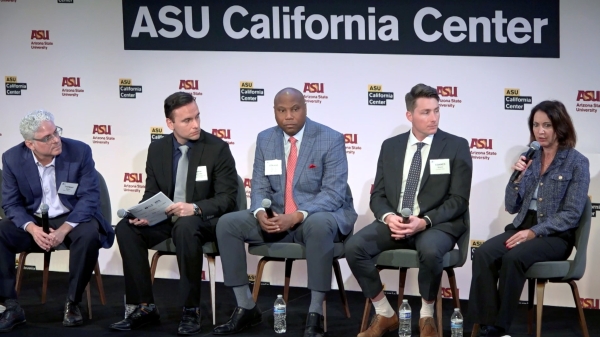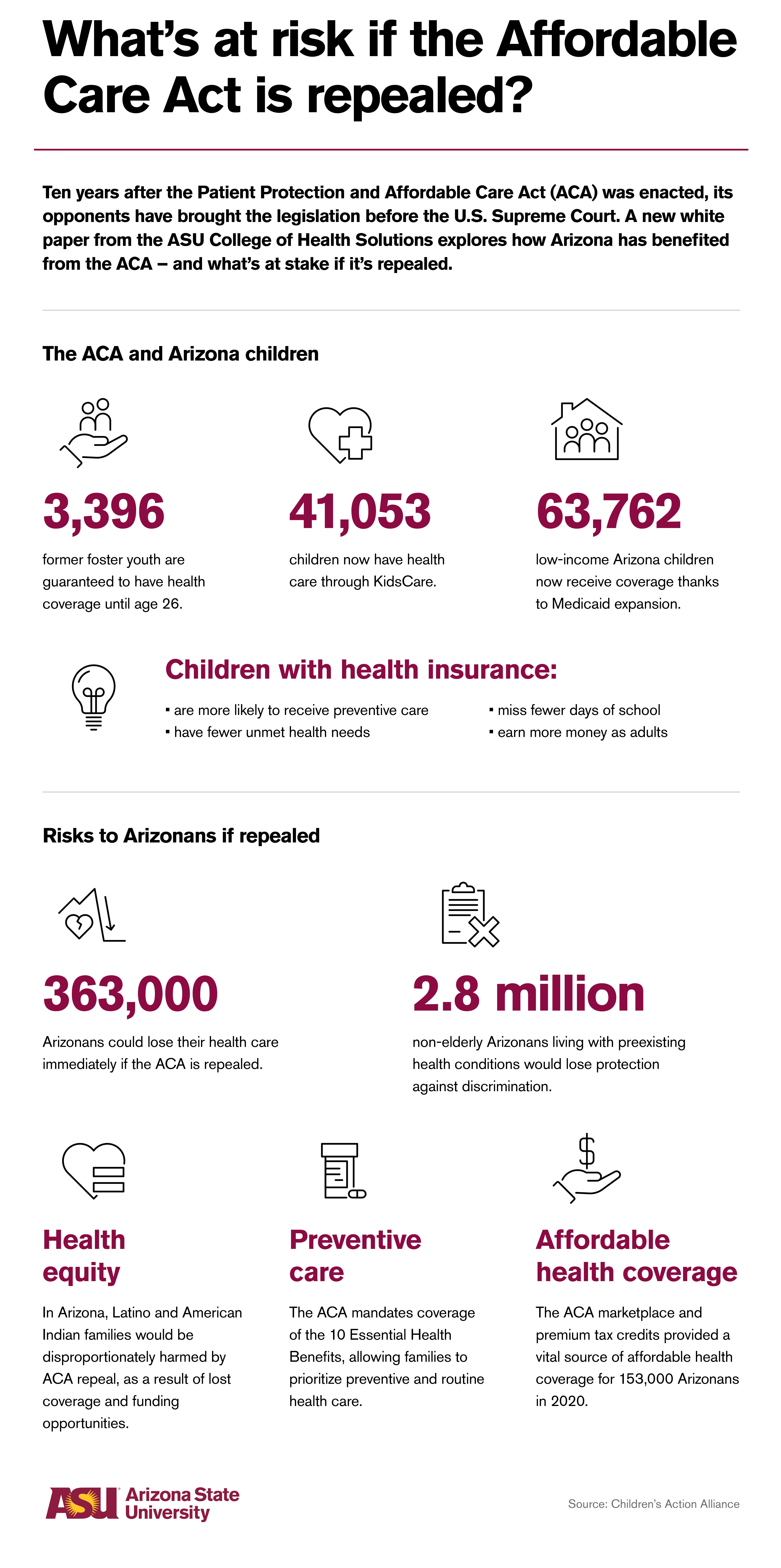ASU researchers detail potential effects of repealing Affordable Care Act

It wasn’t until a severe car crash left her needing medical care she could not afford that Swapna Reddy understood the value of a good health insurance plan.
“Health insurance is one of those things you don't think about until you really need it,” said Reddy, Clinical Assistant Professor in Arizona State University's College of Health Solutions. “You’re healthy until the moment you're not. We don't predict when we become unhealthy and need health care.”
We also don’t predict pandemics.
In collaboration with the Phoenix-based nonprofit Children’s Action Alliance, Reddy and a team of researchers that included College of Health Solutions Faculty Research Associate Matthew Speer and Research Project Coordinator Mary Saxon recently released a white paper detailing the potential effects an upcoming Supreme Court hearing could have on Arizona children, minorities and vulnerable populations should it result in the repeal of the Affordable Care Act (ACA) — effects that would assuredly be exacerbated by COVID-19.
The report illustrates how the ACA has helped close gaps in health coverage for minorities and vulnerable populations in Arizona and highlights the many ways the law has helped promote access to care.
“This report is less about if somebody likes the Affordable Care Act or the president that authored it,” Reddy said. “It's about the need for affordable, accessible and comprehensive health insurance in this country, and the wide-ranging implications — what happens when we don't have that.”
ASU Now met on Zoom with Reddy, her team and Children’s Action Alliance Director of Health Policy Zaida Dedolph to delve into the findings of the report.
Question: What were the key provisions of the Affordable Care Act that this report examined?
Dedolph: The report is tremendous, it’s almost 40 pages long, and even then, it only covers five key provisions of the ACA. And while there are so many more that have completely reshaped the landscape of the American health care system, we wanted to look at just a few that have been especially impactful on making preventive care an affordable reality for many parents and children. That said, we looked at Medicaid expansion, protections for preexisting conditions, 10 essential health benefits, health insurance marketplace and dependent coverage to the age of 26.
Q: Broadly speaking, what has the ACA improved?
Speer: I think, broadly speaking, laws and policies are very much a reflection of a given society's values. And the ACA is no exception to that. So the ACA's intent, broadly speaking, was trifold: to increase coverage, or expand coverage; to reduce cost; and to improve quality. And across the board, I think we can say that you had a lot of wins in all three of those areas, but especially in the expansion of coverage piece, and especially for vulnerable populations.
Graphic by Alex Davis/ASU Media Relations and Strategic Communications
Q: What are some of the positive effects specific to vulnerable populations and minorities in Arizona?
Dedolph: Latinx children and American Indian children are significantly less likely to be insured than their non-Latinx and non-American Indian peers. And one of the things that the ACA has done is provide more options to Latinx and American Indian parents. We know that Latinx parents are more likely to be engaged in the workforce than non-Latinx families. But they're less likely to receive health coverage through their jobs. So, for that reason, the ACA marketplace has been a phenomenal help for the Latinx population. And then, for those families that are working seasonally or who are engaged in more than one part time job, they’re still able to get continual coverage. The impact that the ACA has had on bolstering the financial health of rural and tribal hospital facilities is really critical. It has allowed for the permanent reauthorization of the Indian Health Care Improvement Act. So tribal nations no longer have to go back to Congress to have that approved every few years.
The other thing that it did, particularly for tribal nations, was it allowed Indian Health Service facilities to work with other payers, like Medicare, Medicaid and private insurance, which previously they could not do. And that allows those facilities to bring in providers that they might not otherwise have had, make improvements to their facilities and bring in new equipment and technologies. So people no longer have to travel 100 miles or more to go to a regular doctor visit. The services are available to people when they need them and where they need them. Another vulnerable population the ACA has helped is former foster youth, because it allows them to stay on Medicaid until age 26. We know that former foster youth have encountered so much trauma, and really being able to stay connected to health coverage and not have to worry about that is so incredibly important to the young people that we work with who have aged out of foster care. And that was not an option prior to the Affordable Care Act.
Q: What are some of the negative implications of repealing it?
Saxon: There are 363,000 Arizonans who would lose their health care if the ACA is repealed. That's a huge population. And over 63,000 children have gotten coverage under the Medicaid expansion provisions. Taking COVID into account, there are about 78 million Americans who live in a home with someone who has been unemployed, and about 61% of those individuals are at risk for losing their employer-based health insurance. And that's really critical now more than ever, because we know a lot of Americans get their insurance through their employers.
Speer: Another thing I think is worth noting is that we estimate that prior to the ACA, about 2.8 million non-elderly Arizonans would have qualified as having a preexisting condition that would have met criteria for insurers to discriminate, to deny coverage, to increase costs. That's obviously an incredibly large population in the state, and as to what would happen after the results of this case are heard, come spring 2021... it's kind of anyone's guess. But that's a lot of people and a lot of dire implications for Arizonans.
Q: Without the ACA, what are people’s options if they lose their health insurance due to unemployment?
Reddy: People really don't have a ton of options. Their options tend to look like Cobra, Medicaid and the ACA marketplace. That's for most people, in most places. Cobra is very expensive and cost prohibitive for most individuals in the U.S. to use for the long-term. In fact, it's not intended as a long-term form of insurance, it's really intended to be short-term. So what are we left with? We're left with Medicaid and we're left with the ACA marketplaces, in most places. Because most people, if they don't have employment, they don't necessarily have duffle bags of money to just go buy private health insurance.
Q: How has the pandemic affected the ACA?
Reddy: We did not begin this report thinking about how the pandemic was connected with the fate of the ACA but it ended up becoming something that we could not ignore because of the record numbers of unemployment, and within that, so many people — and their dependents; partners, children, etc. — who depend on health insurance coverage through their employer. So the implications are tremendous. This law was not created necessarily with something like this in mind. But what an incredible safety net is has ended up becoming, unwittingly, in this pandemic. And what we’re seeing is how some key provisions of the ACA are acting as a safety net for people.
One is Medicaid expansion. In Arizona, just under 500,000 people have received Medicaid through the expansion. That's not no one. That's a lot of individuals who were not eligible before. Another key provision of the Affordable Care Act are these ACA insurance marketplaces. Arizona ends up becoming this really interesting case study for that because we had one of the most robust marketplaces when they opened. Then a lot of insurers pulled out of Arizona in 2016, during the presidential election. For a short period of time in that summer, Pinal County didn't have an insurer that was offering plans through the marketplace. That was definitely not good and not the way the marketplaces were designed. The premiums were quite high.
But then in 2018, 2019, and 2020, we have insurers coming back to Arizona and our premiums have largely stabilized. And what we see is a pretty resilient ACA marketplace, which again, is serving as this really important safety net and this really important option during the pandemic in a way that we had not ever envisioned. So even though there have been all these small papercuts to the ACA, this sort of incremental dismantling, what we still see is a pretty resilient piece of legislation, all things considered.
Q: Who do you want to see this report, and what do you hope they get out of it?
Speer: I think our hope here, through the process of crafting this report, and the way that it was crafted, was to de-politicize the ACA. Because from our perspective, what we’re trying to accomplish here, is just to say, here is what the ACA has accomplished. And the world in which we could write a new report that’s asking how we build on the ACA rather than how we prevent it from being torn down, that's the kind of world I would like to live in.
Reddy: I think it's really important for this to get in the hands of voters, policymakers and other stakeholders because it's hard, frankly, at this moment, to get information that you can trust — evidence-based information — on these issues. So we hope that this report can serve as an evidence-based source for people who really need to understand what the law is at the federal level and what the real implications of potentially repealing it would be, especially for all of us average Arizonans who fall under the many categories that would be affected. I think what the report also represents is the importance of partnerships between academic and community-based organizations to produce high-quality, evidence-based research on these really important topics. Because there are so many narratives in our society right now, and lots of different dialogues happening. But the need for evidence-based information is higher than ever. The stakes are higher than ever, and the health of our nation is literally at risk there.
Top photo courtesy of Pixabay
More Law, journalism and politics

TechTainment conference explores the crossroads of law, technology, entertainment
What protections do writers, actors, producers and others have from AI? Will changing laws around name, image and likeness (NIL) eliminate less lucrative college sports?And what does the No…

How to watch an election
Every election night, adrenaline pumps through newsrooms across the country as journalists take the pulse of democracy. We gathered three veteran reporters — each of them faculty at the Walter…
Law experts, students gather to celebrate ASU Indian Legal Program
Although she's achieved much in Washington, D.C., Mikaela Bledsoe Downes’ education is bringing her closer to her intended destination — returning home to the Winnebago tribe in Nebraska with her…
